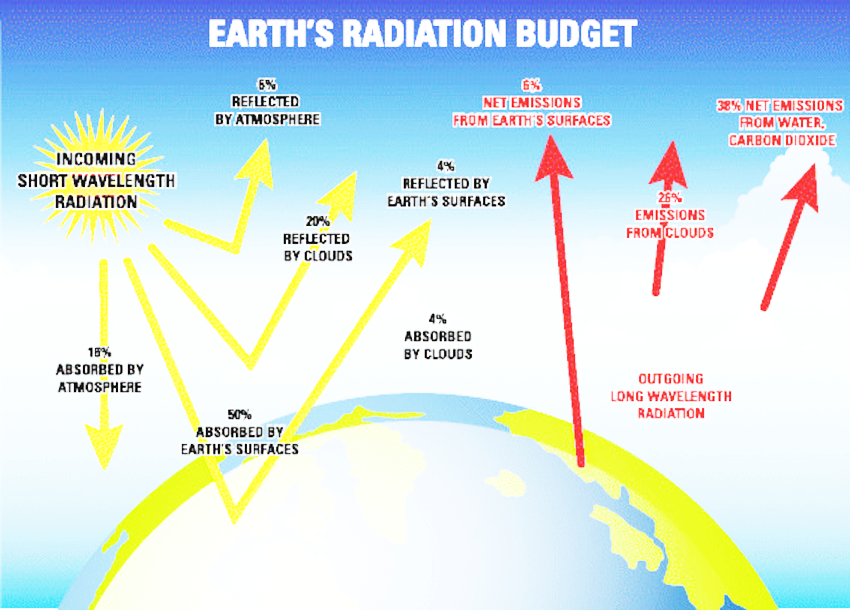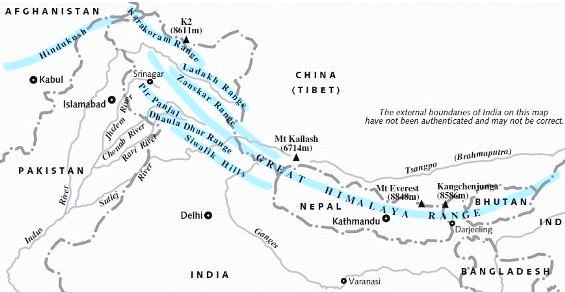Geography
Warming of High Altitude Himalayas
- 11 Feb 2022
- 6 min read
For Prelims: Himalayas, Precipitable Water Vapour (PWV), Aerosols, Greenhouse gas, Radiation budget, Troposphere,
For Mains: Geographical Features and their Location, Environmental Pollution & Degradation, Himalayas and its significance
Why in News?
According to a recent study, water vapour exhibits a positive radiative effect at the Top of the Atmosphere (TOA), suggesting an increase in overall warming in the High Altitude Himalayas due to it.
What is Water Vapour?
- About:
- Water vapour is the state of water when it is in the hydrosphere.
- It can be achieved by water evaporation or boiling of water or by sublimation of ice. Water vapour is the most dominant of greenhouse gases.
- In fact, 95% of greenhouse gases are water vapour. Increased levels of carbon dioxide increase water vapour, which leads to warmer temperatures.
- Significance:
- Water vapour plays a dominant role in the radiative balance and the hydrological cycle.
- It is a principal element in the thermodynamics of the atmosphere, it transports latent heat, it contributes to absorption and emission in a number of bands and it condenses into clouds that reflect and absorb solar radiation, thus directly affecting the energy balance.
What Does the Recent Research Say?
- It shows the atmospheric radiative effect due to Precipitable Water Vapour (PWV) is about 3-4 times higher compared to aerosols, resulting in atmospheric heating rates of 0.94 and 0.96 K Day-1 (K=Kelvin) at Nainital and Hanle, respectively.
- Radiative forcing or effect is the change in energy flux in the atmosphere caused by natural or anthropogenic factors of climate change as measured by watts/metre². It is a scientific concept used to quantify and compare the external drivers of change to Earth's energy balance.
- The results highlight the importance of PWV and aerosol radiative effects in the climate-sensitive Himalayan region.
- The researchers assessed the combination of aerosols and water vapour radiative effects over the Himalayan range that is specifically important for regional climate and highlighted the importance of water vapour as a key greenhouse gas and climate forcing agent over the Himalayan region.
- The study will provide a comprehensive investigation of the combined impact of aerosols and water vapour on the radiation budget.
- The Earth radiation budget (ERB) is a combination of the broadband fluxes of solar radiation reflected by Earth and the fluxes of longwave radiation absorbed and emitted by Earth and its atmosphere.
What is Precipitable Water Vapour?
- It is one of the most rapidly varying components in the atmosphere and is mainly accumulated in the lower troposphere.
- Troposphere: The troposphere is the lowest layer of Earth's atmosphere and most of the mass (about 75-80%) of the atmosphere is in the troposphere. Most types of clouds are found in the troposphere, and almost all weather occurs within this layer.
- It is equivalent to the depth of liquid water that would result if all the water vapor in the atmospheric column is condensed and precipitated, and is used to diagnose the atmospheric humidity over a specific location.
Why are Such Studies Needed?
- Due to the large variability of PWV in space and time, mixing processes and contribution to a series of heterogeneous chemical reactions, as well as sparse measurement networks, especially in the Himalayan region, it is difficult to accurately quantify the climatic impact of PWV over space and time.
- Moreover, aerosol-cloud-precipitation interactions over this region, which are one of the most climatic-sensitive regions, are poorly understood, apparently due to a lack of proper observational data.
What are the Himalayas?
- About:
- The Himalayas are the highest and the youngest fold mountain ranges of the world.
- Their geological structure is young, weak and flexible since the Himalayan uplift is an ongoing process, making them one of the highest earthquake-prone regions of the world.
- It separates India, along its north-central and northeastern frontier, from China (Tibet).
- Area:
- The Indian part of Himalayas covers an area about 5 lakh km2 (about 16.2% of the country's total geographical area) and forms the northern boundary of the country.
- The region is responsible for providing water to a large part of the Indian subcontinent. Many rivers considered holy like the Ganga and Yamuna flow from the Himalayas.
- Ranges:
- The Himalayas are a series of parallel mountain ranges extending along the North-West to the South-East direction (known as the Strike of the Himalayas). These ranges are separated by longitudinal valleys. They include,
- Trans-Himalayas
- The Greater Himalayas or Himadri
- The Lesser Himalayas or Himachal
- Shiwaliks or the Outer Himalayas
- The Eastern Hills or Purvanchal
- The Himalayas are a series of parallel mountain ranges extending along the North-West to the South-East direction (known as the Strike of the Himalayas). These ranges are separated by longitudinal valleys. They include,








